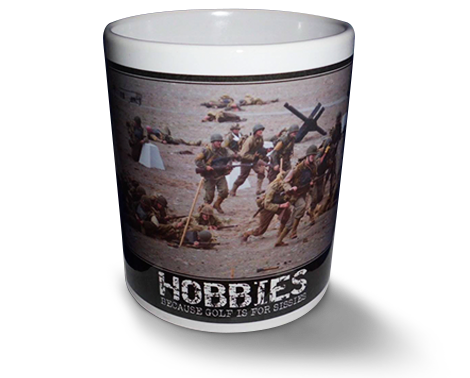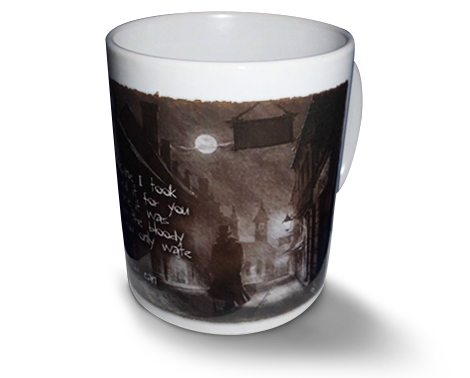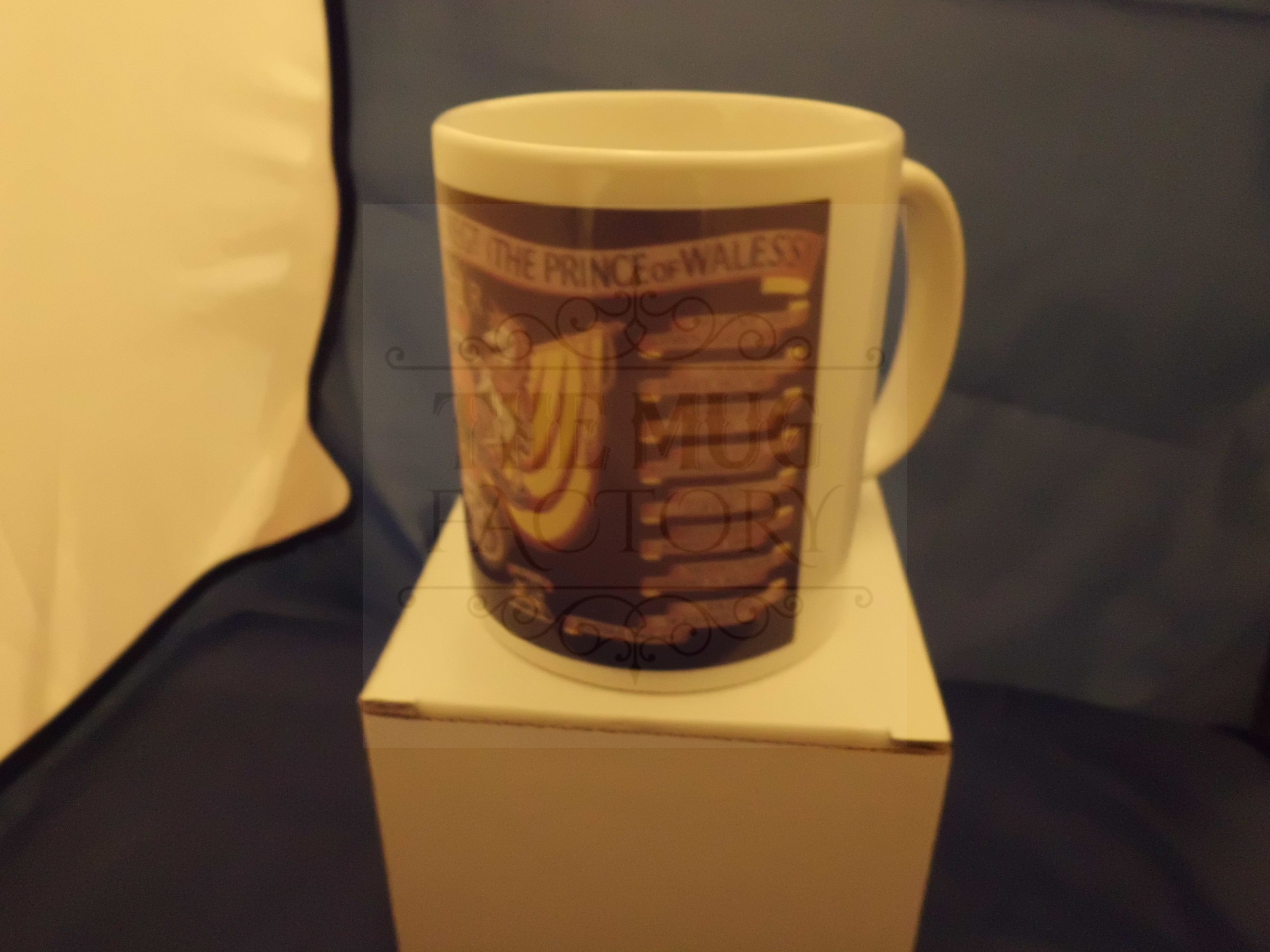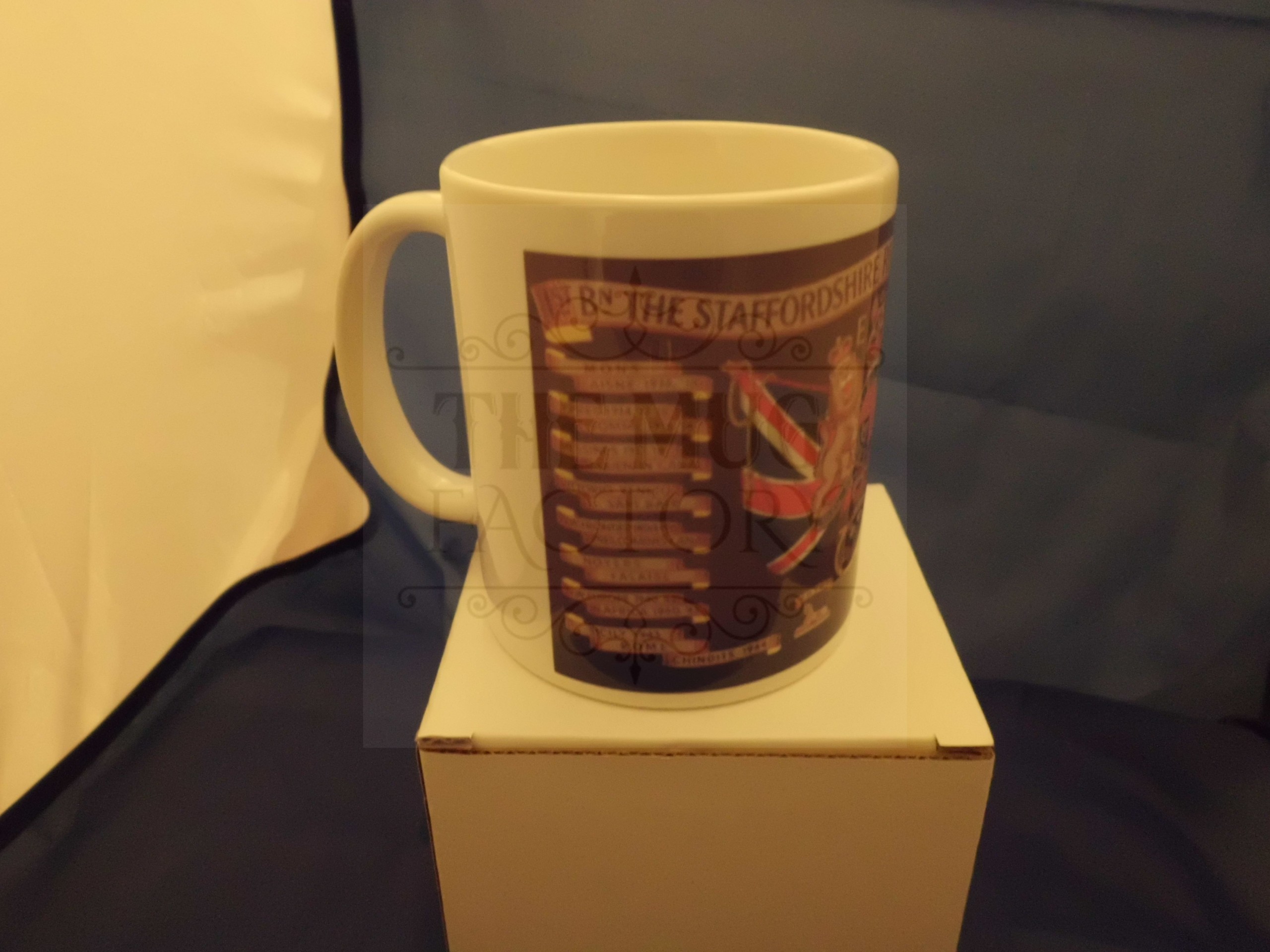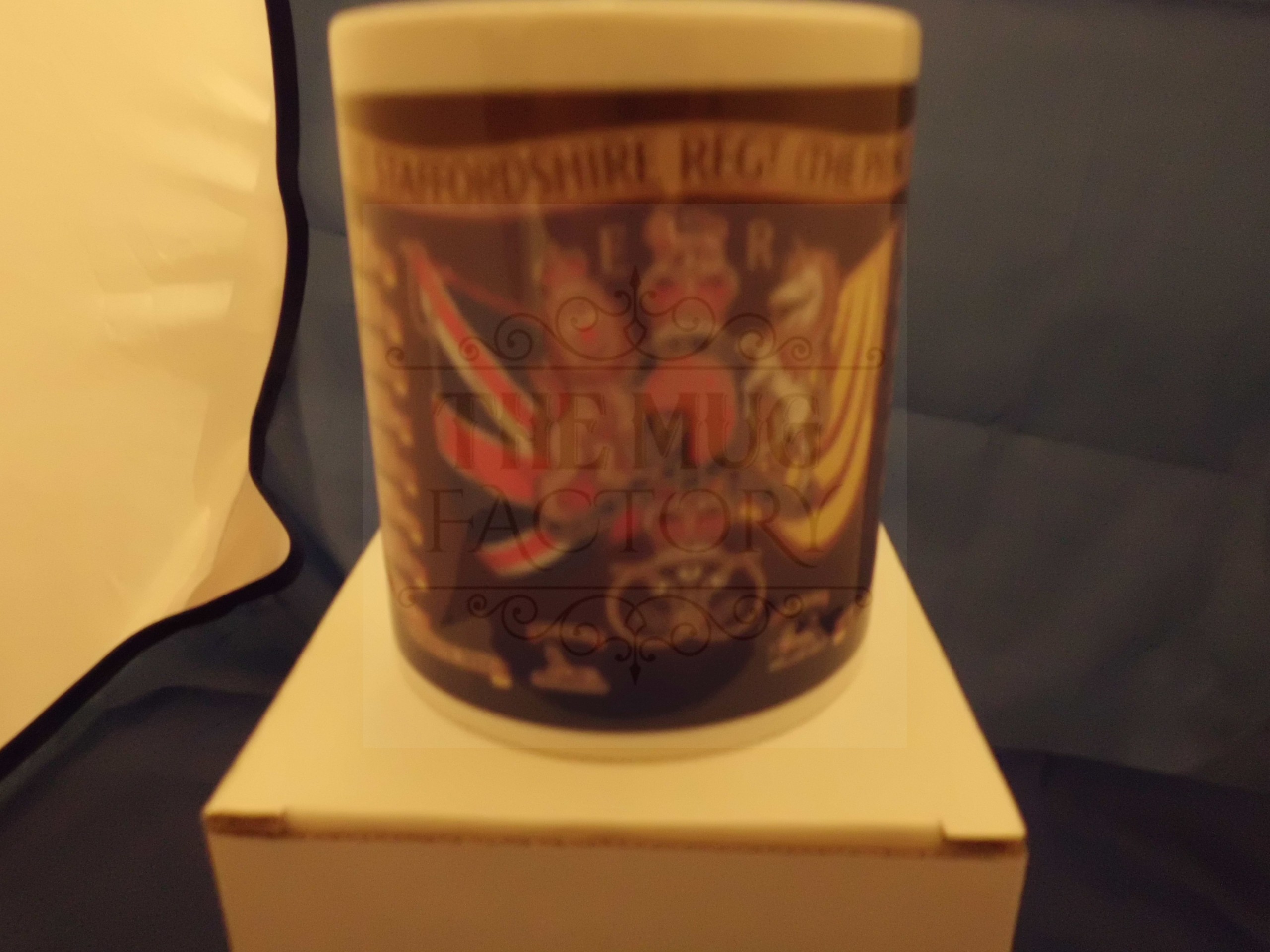1st Battalion Staffordshire regiment military mug
11oz Staffordshire regiment mug
Men born in Staffordshire were soldiers long before a regiment was raised there in the reign of Queen Anne. The Staffordshire Regiment traces its roots to the formation of a Regiment of Foot at Lichfield in 1705 and is unique amongst all of Britain’s infantry regiments in its continuous identity with a single County. A direct link with Staffordshire was established in 1782, when the 38th Foot received the additional title of 1st Staffordshire Regiment and the 64th Foot of 2nd Staffordshire Regiment.
Vast expansion took place in both World Wars but reductions after 1945 saw each of the County Regiments reduced to one Regular Battalion and one Territorial. In 1959 the South and North were amalgamated to form the Staffordshire Regiment (The Prince of Wales’s). The Territorials survived a little longer (1968). The Staffords held on to their independence until the major reorganisation of the Infantry in 2005-2007. On 1 September 2007 they merged with the 22nd (Cheshire) Regiment, the Worcestershire and Sherwood Foresters Regiment and the Territorials of the West Midlands Regiment to become the four-battalion Mercian Regiment. The traditions and ethos of the Staffords are carried forward by the 3rd Battalion The Mercian Regiment (Staffords) under the proud motto: Stand Firm, Strike Hard.
The South Staffordshire and North Staffordshire Regiments were created out of four of the old numbered regiments, which for the South included the 80th Staffordshire Volunteers, in 1881. From that period too, the old County militias and volunteers were linked directly with their Regular Army counterparts. These links were regularised further by the formation of the Territorial Force in 1908, by which year both South and North Staffords each had six battalions: two Regular, two Militia and two Territorial.
The first ancestor of The Staffordshire Regiment, the 38th Regiment of Foot, was raised during the War of the Spanish Succession by Col Luke Lillingston at the Kings Head, Lichfield, on 26 Mar 1705. Shortly afterwards, in 1707, it was sent to Antigua, in the West Indies, remaining there until 1764, the longest overseas posting recorded in the British Army. Resupply shortages forced the men to wear the local sugar sacking (‘holland cloth’), commemorated by the Holland Patch worn to this day.
The second ancestor of the Regiment, was raised in 1756 during the Seven Years’ War, initially as the 2nd Battalion of the 11the Regiment of Foot but granted its own number, the 64th of Foot, in 1758. It too was posted to the West Indies and there captured Gaudeloupe alongside the 38th; they jointly share the first Battle Honour of the Regiment. They subsequently both fought in the American War of Independence, never surrendering to or retreating from the enemy.
four regiments took part in the larger wars of the second half of the century, with the 38th especially active and involved in the both Crimea and the Indian Mutiny. Later in the century, renamed 1st South Staffords as part of the Cardwell reforms of the 1870s, it took part in the Nile campaign (including the attempt to save Gen Gordon at Khartoum) and in the Boer War. The 64th also took part in the Indian Mutiny, when Drummer Flynn won the Victoria Cross, and later, renamed the 1st North Staffords, fought in the Sudan (Dongola campaign). The 80th fought in the Zulu Wars, winning two VCs, including the only VC actually awarded at the time of Isandlwala; this went to Pte Wassall; it subsequently became 2nd South Staffords. The 98th fought in the Boer War; by then it was titled 2nd North Staffords but had earlier been granted the Title ‘Prince 0f Wales’s’ by the future King Edward VII whilst in Malta in 1876.
During the Napoleonic Wars, the 38th fought in the Flanders area alongside the 80th Regiment of Foot (The Staffordshire Volunteers), formed in 1793. The 38th subsequently fought in South Africa, South America (Montevideo) and in the Peninsular under Wellington whilst the 80th also fought in South Africa, assisting in the capture of a Dutch Naval Squadron and in Egypt. For the latter, they gained the Battle Honour of a Sphynx, still used as a symbol today. The 64th remained in the West Indies throughout, capturing many strategic islands.
During the First World War, the South and North Staffords formed a total of 35 battalions and fought in all major campaigns. In the Second World War they raised 17; both Regiments fought in the desert and the North fought in France in 1940. Subsequently, 2nd North fought in Italy whilst 1st South Staffords were Chindits, winning a VC and 2nd South Staffords were in Airborne Forces as a Glider battalion, being amongst the first British troops to land in mainland Europe (Sicily) and fighting at Arnhem, where they won two VCs, the only time this occurred in World War Two.
After 1945, the North and South became single battalions and served in Palestine, Korea and Cyprus. They were amalgamated into The Staffordshire Regiment in 1959, which continued past its three hundreth anniversary before becoming part of the Mercian Regiment in 2005. In over 45 years of existence, the Staffords have served in many stations, notably Kenya, Germany, N Ireland, Kuwait and Iraq (First Gulf War).
Amidst the colonial expansion of the first half of the nineteenth century, the 98th Regiment of Foot was formed in 1824 but did not see action until 1842, gaining the Battle Honour of a China Dragon, also used as a symbol by The Staffordshire Regiment. It later fought in the Second Sikh War. The 80th escorted convicts to Australia in 1836, remaining on station for 9 years and annexing the South island of New Zealand for the Queen; it subsequently took part in the First Sikh War, where CSgt Matthew Kirkland captured a Sikh standard at the Battle of Ferozeshah, an achievement still commemorated by handing over the Regimental Colours to the Sergeants’ Mess on the anniversary of his achievement. The 80th also fought in the second Burmese war of 1852/3; the 38th had fought in the First Burmese War of 1824/6. The 64th fought with distinction in the Persian war of 1856.
Watchman
The mascot tradition in the Regiments of Staffordshire stretches back to the 19th Century. In 1882 The South Staffordshire Regiment was ordered to march with Lord Wolseley to the relief of General Gordon who was besieged in Khartoum. They entrained at Cairo with their Staffordshire Bull Terrier “Boxer”. Unfortunately Boxer leapt from the moving train and was seen lying unconscious or dead at the side of the track.
A few days later when the Regiment encamped at Assiut awaiting orders for the final phase of their march, a very thin and bedraggled dog staggered into their camp and collapsed. Boxer had walked for over 200 miles along the scorching desert railway track to rejoin his regiment, a true soldier.
From then on the tradition of having a Bull Terrier as a mascot continued with the battalions until after the Second World War.
Created in 1856 the Victoria Cross is Britain’s highest recognition for bravery in the presence of the enemy.
From the Indian Mutiny to the Second World War, thirteen Victoria Crosses have been awarded to the Staffordshire Regiment.
The Indian Mutiny 1857 - 1858
Drummer Thomas Flynn, VC
On 28th November 1857, Cawnpore, India, the 64th regiment attacked a besieging mutineer gun battery. Flynn was severely wounded in the successful charge but continued to fight hand to hand against two of the enemy.
Zulu War 1879
Private Samuel Wassall, VC
On 22nd January 1879 during the battle of Isandhlwana, Wassall was part of a Mounted infantry attached to the central column when it was overwhelmed by Zulus. Some managed to escape to the Buffalo River to the rear but as Wassall urged his horse down the bank he saw a comrade drowning. Wassell dismounted and rescued him under enemy fire successfully escaping.
Sergeant Anthony Clarke Booth, VC
On 12th March 1879 Sergeant Booth was with a company of 80th Regiment encamped on the Intombi River when they were surprised and overwhelmed by Zulus. Booth rallied the survivors and conducted their retreat for three miles.
The Great War 1914-18
Sergeant John Carmichael, VC
On 8th September 1917, during the Third Battle of Ypres, whilst serving in the 9th North Stafford’s, Sergeant Carmichael was in charge of a working party in a trench near Hill 60. One of his men accidently dislodged a grenade activating its fuse. Sergeant Carmichael shouted a warning and placed his steel helmet over the grenade and stood on it. He was wounded but saved his soldiers.
Lieutenant. Colonel Edward Ellers Delaval Henderson, VC
On 25th January 1917 he led his battalion against Turkish positions at Kut-Al-Amara but was wounded and forced to withdraw. He led a second attack again being wounded eventually capturing the position by a bayonet charge. Wounded twice more before being evacuated but died shortly afterwards.
Captain John Franks Vallentin, VC
On 7th November 1914 he was in temporary command of the 1st battalion South Staffordshire Regiment in an attack on a trench near Zillebeke, Ypres. He was wounded but pressed on and was later killed by machinegun fire. The attack was a success due to his inspiring example.
Lance Corporal William Harold Coltman, VC, DCM, MM.
In October 1918 during the assault on the Hindenburg line, and in the face of a German counter-attack, he three times went out into the open to give first aid to wounded men and carry them back to safety. Due to his heroic actions William Coltman has become the most decorated other rank in the British Army.
Private Thomas Barrett, VC
On 27th July 1917 in the Ypres Salient Barrett was acting as scout with a patrol and had already stalked and shot several snipers, when the patrol was forced to withdraw. Barrett covered their retirement, whilst under heavy fire and caused a number of enemy casualties, but on reaching our own lines safely he was killed by a stray shell.
Sergeant John Thomas, VC
On 30th November 1917 at Bourlon Wood Thomas went forward under enemy fire to ascertain German intentions. Shooting three snipers en route, he reached a building used by the enemy as a night listening post. He observed enemy preparations and returned after three hours providing information which enabled artillery to break up the German attack.
Captain Arthur Forbes Gordon Kilby, VC, MC
On 25th September 1915 during the Battle of Loos he led his company in an attack on the La Bassee Canal. He was wounded, and had lost a foot, but led his men right up to the wire where he was shot down. He continued to urge his men forward using his rifle until he died.
World War II
Lieutenant George Albert Cairns, VC
On 12th March 1944 in Burma as part of the ‘Chindits’ he led his men in an attack on ‘Pagoda Hill’. A Japanese officer hacked off his left arm with a sword and although severely wounded continued to lead his men, personally killing several of the enemy before collapsing and dying.
Major Robert Henry Cain, VC
From 19th September 1944 over a period of several days Major Cain led the defence of part of the Oosterbeek perimeter near Arnhem. On several occasions he successfully attacked enemy tanks using a PIAT. Although suffering multiple wounds he encouraged his men by his daring leadership and fearless example refusing rest and medical attention.
Lance Sergeant John (Jack) Daniel Baskeyfield, VC
On 20th September 1944 at Arnhem he commanded two 6-pdr Anti-Tank guns in defensive positions at Oosterbeek. His section repulsed a German attack destroying two tanks and a self propelled gun but Baskeyfield and his section were all wounded. Baskeyfield refused first aid and continued to use his gun until it was put out of action by enemy fire. He then crawled to another gun whose crew had been killed and with it scored a direct hit an another German self propelled gun. He was then killed by an enemy tank shell.
The awards issued to Lance Sergeant Baskeyfield and Major Cain was the only occasion during the Second World War, where two Victoria Crosses were awarded to a single army unit for the same battle.

